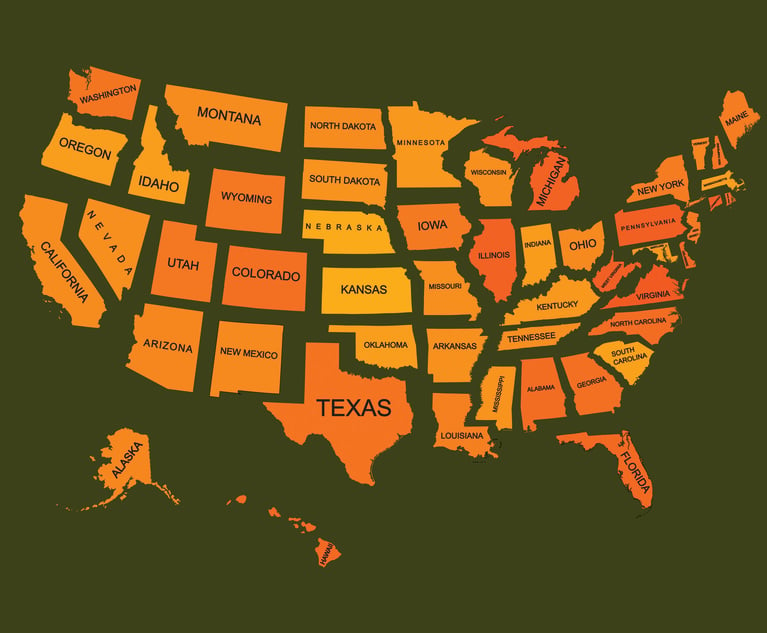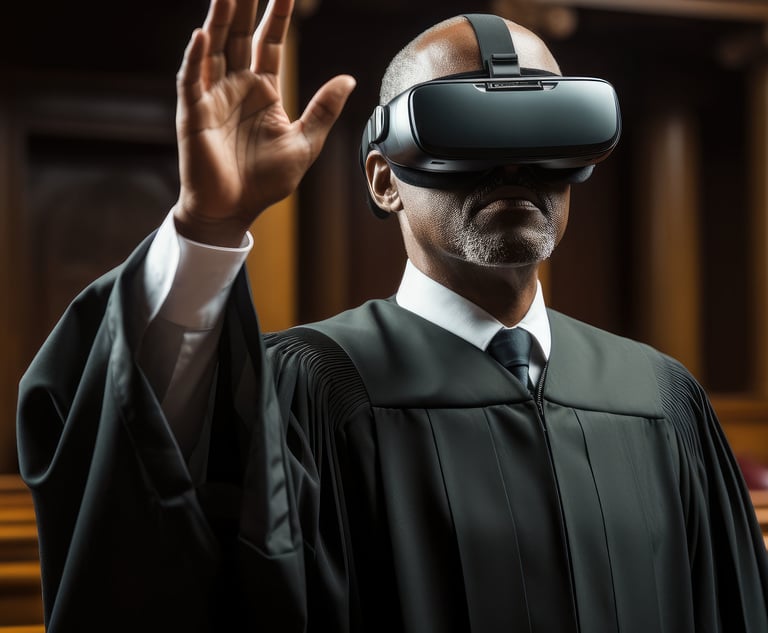Inside the 'Google-style' Tech Hub Driving Plaintiffs Firms' Growth
Litigation software has been a "game-changer" for plaintiff firms, revolutionizing how cases are processed and ultimately increasing their bottom line.
November 15, 2021 at 11:07 AM
5 minute read
The original version of this story was published on National Law Journal
What You Need to Know
- Litigation software allows plaintiffs firms to process cases consistently and at scale.
- Investment in legal technology ultimately translates into revenue increases, experts suggest.
- Past legal tech adoption proved key to plaintiffs firms' success during pandemic.
 The Morgan & Morgan technology operations center in Brooklyn, New York. Photo: Ryland West/ ALM[/caption] For anyone who has seen Morgan & Morgan's national TV ads, founder John Morgan's stance on law firm growth is clear—size matters and bigger is better for getting clients the best results. But what has enabled much of that growth, Morgan said, is the behind-the-scenes technology that fundamentally changed the way cases were processed in his firm. Morgan's vision was to build a "Google-style" operation with technology ultimately transforming his company from a law firm to a technology firm. With firm COO Reuven Moskowitz, a separate entity, Litify, was formed in 2016. Five years in, the practice management software has helped Morgan & Morgan and many of its competitors grow their caseloads. Morgan & Morgan, by the firm's own account, now employs 801 attorneys and almost 3,000 support staff nationwide. Since the introduction of Litify growth has been up 500 percent both in case numbers and total revenue, the firm said without specifying any further. Morgan & Morgan's technology core is located in Brooklyn where about 65 legal tech and digital staff keep Litify running in an almost Silicon Valley-style setting. The result: "Our case numbers grow every year by double digits, but also case values are up, client satisfaction is up," Moskowitz said. The firm, by its own account, has sold its litigation processing software to 250 other plaintiff firms. And after a $50 million fundraising round in 2019, had intended to focus on law departments and midsized firms as well. "The law community is realizing that technology is unlocking value," said Tony Donofrio, CTO of Veritext Legal Solutions, a legal technology company that has provided digital solutions to law firms for more than 20 years. "Now, firms are moving to integration across the board, how they work is all tech-enabled." The recent law firm evolution is based on seeing technology as a multiplying factor rather than a cost—firms should reinvest "10-15% of revenue in new technology." Before Litify "we had a consistency issue," Morgan & Morgan managing partner Matt Morgan said. He is John Morgan's son and recalls how thousands of personal injury cases were initially moved from classic filing cabinets to Google sheets. "You can only imagine, how archaic, how difficult it was" to handle thousands of PI cases all over the United States. With the introduction of its own litigation software, the firm was finally able to evaluate "actionable data points" about personal injury settlements or court proceedings. "If we see 9 times out of 10 that a certain type of case would go a certain way, we could ask a lawyer to work up a case accordingly—and we could do that at scale," Matt Morgan explained. "What we can do is to make the process objective, not subjective," John Morgan said. He calls it the "dirty secret" of personal injury law "that probably 90 percent of all cases are settled at the last best offer"—and that is not always the best offer for the plaintiff. With its cloud-based litigation software, Morgan & Morgan attorneys are now forced to apply consistent standards across personal injury cases diminishing the risk of undervaluing cases at settlement. As larger firms work through similar technology implementation and their own tech spinoffs and subsidiaries, personal injury firms have long had to leverage technology to connect with potential clients and generate leads. The further use of practice management software appears to be enabling those firms to better harness and expand those opportunities, providing the scale their size does not. "Integration matters a lot more when you are smaller, when you have less resources," Donofrio said, stressing the need for smaller firms to explore legal tech solutions. The pandemic and remote work have only underscored the urgency for law firms to invest more in remote work technologies. "I don't think we could have gone through it [the pandemic] as seamlessly without it," said Shawn Lehocky, CEO of Pond Lehocky Giordano. His firm adopted the Litify case management platform in 2016. "It's long overdue for our industry to move in that direction." This software tool has allowed him to instantly see if "cases are coming in or not." He calls the ability to have immediate access data points about his firm's case load "a game-changer" allowing him to make marketing adjustments as needed. The use of cloud-based litigation software has led to referrals of cases to other firms. "I now know instantaneously, if the other firm took on the case, if they opened our referral email,' Lehocky said—and that is ultimately good for the client. "We are dealing with real people and they need help." Morgan & Morgan is not the only firm that has developed its own case processing technology. "Acumen, powered by Robins Kaplan—that is the gold standard," said Stacey Slaughter, a partner and executive board member of Robins Kaplan. The e-discovery platform streamlines processing of litigation documents, but more importantly provides access to experts and trial consultants in the fields of science, financial and business analytics as well as case investigators. "We have a well-oiled machine," Slaugther said, pointing to a fully digitized litigation process, "our people are top notch." Robins Kaplan has also provided this platform to other law firms. With a talent war impacting firms across the United States, legal technology application at plaintiffs firms plays an important role when it comes to retention. "When new attorneys come into firms, this is going to matter—kids coming out of law school are not going to look through filing cabinets anymore," Donofrio said.
The Morgan & Morgan technology operations center in Brooklyn, New York. Photo: Ryland West/ ALM[/caption] For anyone who has seen Morgan & Morgan's national TV ads, founder John Morgan's stance on law firm growth is clear—size matters and bigger is better for getting clients the best results. But what has enabled much of that growth, Morgan said, is the behind-the-scenes technology that fundamentally changed the way cases were processed in his firm. Morgan's vision was to build a "Google-style" operation with technology ultimately transforming his company from a law firm to a technology firm. With firm COO Reuven Moskowitz, a separate entity, Litify, was formed in 2016. Five years in, the practice management software has helped Morgan & Morgan and many of its competitors grow their caseloads. Morgan & Morgan, by the firm's own account, now employs 801 attorneys and almost 3,000 support staff nationwide. Since the introduction of Litify growth has been up 500 percent both in case numbers and total revenue, the firm said without specifying any further. Morgan & Morgan's technology core is located in Brooklyn where about 65 legal tech and digital staff keep Litify running in an almost Silicon Valley-style setting. The result: "Our case numbers grow every year by double digits, but also case values are up, client satisfaction is up," Moskowitz said. The firm, by its own account, has sold its litigation processing software to 250 other plaintiff firms. And after a $50 million fundraising round in 2019, had intended to focus on law departments and midsized firms as well. "The law community is realizing that technology is unlocking value," said Tony Donofrio, CTO of Veritext Legal Solutions, a legal technology company that has provided digital solutions to law firms for more than 20 years. "Now, firms are moving to integration across the board, how they work is all tech-enabled." The recent law firm evolution is based on seeing technology as a multiplying factor rather than a cost—firms should reinvest "10-15% of revenue in new technology." Before Litify "we had a consistency issue," Morgan & Morgan managing partner Matt Morgan said. He is John Morgan's son and recalls how thousands of personal injury cases were initially moved from classic filing cabinets to Google sheets. "You can only imagine, how archaic, how difficult it was" to handle thousands of PI cases all over the United States. With the introduction of its own litigation software, the firm was finally able to evaluate "actionable data points" about personal injury settlements or court proceedings. "If we see 9 times out of 10 that a certain type of case would go a certain way, we could ask a lawyer to work up a case accordingly—and we could do that at scale," Matt Morgan explained. "What we can do is to make the process objective, not subjective," John Morgan said. He calls it the "dirty secret" of personal injury law "that probably 90 percent of all cases are settled at the last best offer"—and that is not always the best offer for the plaintiff. With its cloud-based litigation software, Morgan & Morgan attorneys are now forced to apply consistent standards across personal injury cases diminishing the risk of undervaluing cases at settlement. As larger firms work through similar technology implementation and their own tech spinoffs and subsidiaries, personal injury firms have long had to leverage technology to connect with potential clients and generate leads. The further use of practice management software appears to be enabling those firms to better harness and expand those opportunities, providing the scale their size does not. "Integration matters a lot more when you are smaller, when you have less resources," Donofrio said, stressing the need for smaller firms to explore legal tech solutions. The pandemic and remote work have only underscored the urgency for law firms to invest more in remote work technologies. "I don't think we could have gone through it [the pandemic] as seamlessly without it," said Shawn Lehocky, CEO of Pond Lehocky Giordano. His firm adopted the Litify case management platform in 2016. "It's long overdue for our industry to move in that direction." This software tool has allowed him to instantly see if "cases are coming in or not." He calls the ability to have immediate access data points about his firm's case load "a game-changer" allowing him to make marketing adjustments as needed. The use of cloud-based litigation software has led to referrals of cases to other firms. "I now know instantaneously, if the other firm took on the case, if they opened our referral email,' Lehocky said—and that is ultimately good for the client. "We are dealing with real people and they need help." Morgan & Morgan is not the only firm that has developed its own case processing technology. "Acumen, powered by Robins Kaplan—that is the gold standard," said Stacey Slaughter, a partner and executive board member of Robins Kaplan. The e-discovery platform streamlines processing of litigation documents, but more importantly provides access to experts and trial consultants in the fields of science, financial and business analytics as well as case investigators. "We have a well-oiled machine," Slaugther said, pointing to a fully digitized litigation process, "our people are top notch." Robins Kaplan has also provided this platform to other law firms. With a talent war impacting firms across the United States, legal technology application at plaintiffs firms plays an important role when it comes to retention. "When new attorneys come into firms, this is going to matter—kids coming out of law school are not going to look through filing cabinets anymore," Donofrio said.This content has been archived. It is available through our partners, LexisNexis® and Bloomberg Law.
To view this content, please continue to their sites.
Not a Lexis Subscriber?
Subscribe Now
Not a Bloomberg Law Subscriber?
Subscribe Now
NOT FOR REPRINT
© 2025 ALM Global, LLC, All Rights Reserved. Request academic re-use from www.copyright.com. All other uses, submit a request to [email protected]. For more information visit Asset & Logo Licensing.
You Might Like
View All
The Week in Data Dec. 13: A Look at Legal Industry Trends by the Numbers
Law Firms Mentioned
Trending Stories
Who Got The Work
J. Brugh Lower of Gibbons has entered an appearance for industrial equipment supplier Devco Corporation in a pending trademark infringement lawsuit. The suit, accusing the defendant of selling knock-off Graco products, was filed Dec. 18 in New Jersey District Court by Rivkin Radler on behalf of Graco Inc. and Graco Minnesota. The case, assigned to U.S. District Judge Zahid N. Quraishi, is 3:24-cv-11294, Graco Inc. et al v. Devco Corporation.
Who Got The Work
Rebecca Maller-Stein and Kent A. Yalowitz of Arnold & Porter Kaye Scholer have entered their appearances for Hanaco Venture Capital and its executives, Lior Prosor and David Frankel, in a pending securities lawsuit. The action, filed on Dec. 24 in New York Southern District Court by Zell, Aron & Co. on behalf of Goldeneye Advisors, accuses the defendants of negligently and fraudulently managing the plaintiff's $1 million investment. The case, assigned to U.S. District Judge Vernon S. Broderick, is 1:24-cv-09918, Goldeneye Advisors, LLC v. Hanaco Venture Capital, Ltd. et al.
Who Got The Work
Attorneys from A&O Shearman has stepped in as defense counsel for Toronto-Dominion Bank and other defendants in a pending securities class action. The suit, filed Dec. 11 in New York Southern District Court by Bleichmar Fonti & Auld, accuses the defendants of concealing the bank's 'pervasive' deficiencies in regards to its compliance with the Bank Secrecy Act and the quality of its anti-money laundering controls. The case, assigned to U.S. District Judge Arun Subramanian, is 1:24-cv-09445, Gonzalez v. The Toronto-Dominion Bank et al.
Who Got The Work
Crown Castle International, a Pennsylvania company providing shared communications infrastructure, has turned to Luke D. Wolf of Gordon Rees Scully Mansukhani to fend off a pending breach-of-contract lawsuit. The court action, filed Nov. 25 in Michigan Eastern District Court by Hooper Hathaway PC on behalf of The Town Residences LLC, accuses Crown Castle of failing to transfer approximately $30,000 in utility payments from T-Mobile in breach of a roof-top lease and assignment agreement. The case, assigned to U.S. District Judge Susan K. Declercq, is 2:24-cv-13131, The Town Residences LLC v. T-Mobile US, Inc. et al.
Who Got The Work
Wilfred P. Coronato and Daniel M. Schwartz of McCarter & English have stepped in as defense counsel to Electrolux Home Products Inc. in a pending product liability lawsuit. The court action, filed Nov. 26 in New York Eastern District Court by Poulos Lopiccolo PC and Nagel Rice LLP on behalf of David Stern, alleges that the defendant's refrigerators’ drawers and shelving repeatedly break and fall apart within months after purchase. The case, assigned to U.S. District Judge Joan M. Azrack, is 2:24-cv-08204, Stern v. Electrolux Home Products, Inc.
Featured Firms
Law Offices of Gary Martin Hays & Associates, P.C.
(470) 294-1674
Law Offices of Mark E. Salomone
(857) 444-6468
Smith & Hassler
(713) 739-1250











